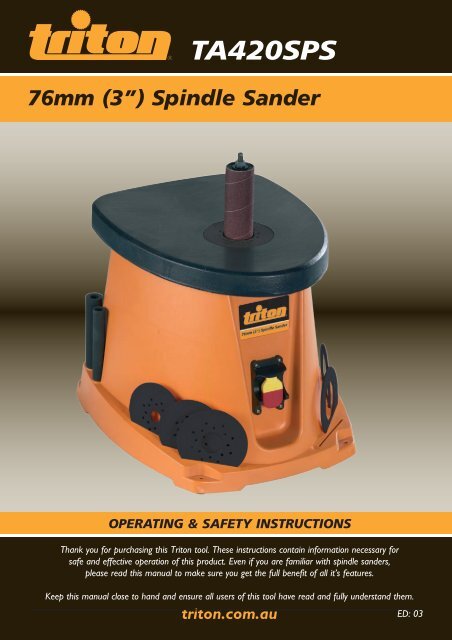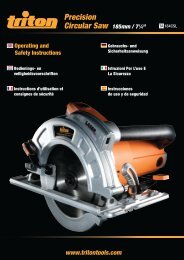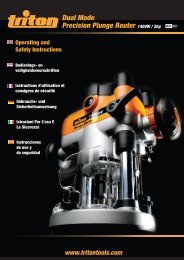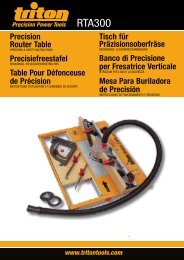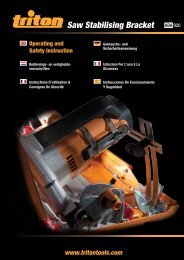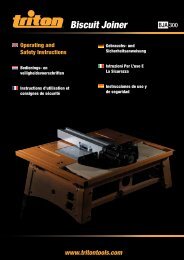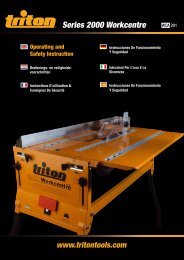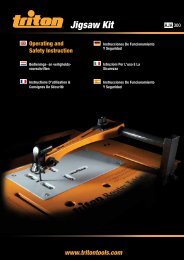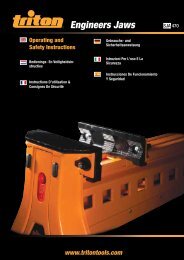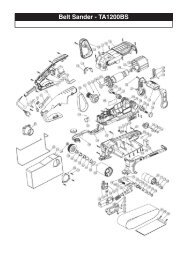(3â) Spindle Sander - Triton Tools
(3â) Spindle Sander - Triton Tools
(3â) Spindle Sander - Triton Tools
You also want an ePaper? Increase the reach of your titles
YUMPU automatically turns print PDFs into web optimized ePapers that Google loves.
TA420SPS<br />
76mm (3”) <strong>Spindle</strong> <strong>Sander</strong><br />
OPERATING & SAFETY INSTRUCTIONS<br />
Thank you for purchasing this <strong>Triton</strong> tool. These instructions contain information necessary for<br />
safe and effective operation of this product. Even if you are familiar with spindle sanders,<br />
please read this manual to make sure you get the full benefit of all it’s features.<br />
Keep this manual close to hand and ensure all users of this tool have read and fully understand them.<br />
triton.com.au<br />
ED: 03<br />
Black<br />
Cyan<br />
Magenta<br />
Yellow<br />
Code: TA420SPS<br />
Date: 070205 Edition: 04 Op: PS
CONTENTS<br />
Specifications 2<br />
Know your product 3<br />
Safety instructions 4<br />
Symbols 6<br />
Assembly 7<br />
Adjustments 9<br />
Operation 9<br />
Maintenance 10<br />
Troubleshooting 11<br />
Warranty 12<br />
<strong>Triton</strong> offices 12<br />
KNOW YOUR PRODUCT<br />
15<br />
13a<br />
4<br />
12<br />
3<br />
2<br />
9 1<br />
SPECIFICATIONS<br />
Model no:<br />
TA420SPS<br />
8<br />
14<br />
8<br />
13b<br />
13c<br />
Voltage:<br />
Input power:<br />
230-240V ~ 50Hz<br />
420W<br />
7<br />
6<br />
No load speed: 2000min -1<br />
Oscillations:<br />
58 OPM<br />
5<br />
Stroke length:<br />
16mm<br />
Sanding sleeve sizes:<br />
13mm, 19mm, 26mm, 38mm, 51mm, 76mm<br />
Dust port:<br />
38mm<br />
Table size:<br />
<strong>Spindle</strong> dimensions:<br />
370mm x 290mm<br />
12.7mm x 1.5mm thread<br />
10<br />
11<br />
Insulation:<br />
Double insulated<br />
Net weight:<br />
14.6kg (32.1 lbs)<br />
1. On/off switch<br />
2. Motor housing<br />
3. Table top<br />
4. <strong>Spindle</strong><br />
5. Table insert (x6)<br />
6. Rubber drum (x5)<br />
7. Sanding sleeve (x6)<br />
8. On-board table insert storage<br />
9. On-board spindle storage<br />
(Rubber drums and sleeves)<br />
10. Dust port<br />
11. Dust adaptor (x2)<br />
12. Lower spindle washer<br />
13. Upper spindle washers (x3)<br />
a. Small<br />
b. Medium<br />
c. Large<br />
14. Wrench<br />
15. <strong>Spindle</strong> lock nut<br />
2<br />
Contents<br />
Know your product 3
SAFETY INSTRUCTIONS<br />
GENERAL SAFETY<br />
INSTRUCTIONS<br />
WARNING. When using power tools,<br />
basic safety precautions should always be<br />
taken to reduce the risk of fire, electric<br />
shock and personal injury. Also, please read<br />
and heed the advice given in the additional<br />
important safety instructions.<br />
1. Keep the work area clean and tidy.<br />
Cluttered work areas and benches invite<br />
accidents and injury.<br />
2. Consider the environment in which<br />
you are working. Do not use power<br />
tools in damp or wet locations. Keep the<br />
work area well lit. Do not expose power<br />
tools to rain. Do not use power tools<br />
in the presence of flammable liquids or<br />
gases.<br />
3. Keep visitors away from the work<br />
area. All visitors and onlookers,<br />
especially children and infirm persons,<br />
should be kept well away from where<br />
you are working. Do not let others in<br />
the vicinity make contact with the tool<br />
or extension cord.<br />
4. Store tools safely. When not in use,<br />
tools should be locked up out of reach.<br />
5. Do not force the tool. The tool will<br />
do the job better and safer working at<br />
the rate for which it was designed.<br />
6. Use the correct tool for the job. Do<br />
not force small tools or attachments to<br />
do the job best handled by a heavier duty<br />
tool. Never use a tool for a purpose for<br />
which it was not intended.<br />
7. Dress correctly. Do not wear loose<br />
clothing or jewellery. They can be caught<br />
in moving parts. Rubber gloves and nonslip<br />
footwear are recommended when<br />
working outdoors. If you have long hair,<br />
wear a protective hair covering.<br />
8. Use safety accessories. Safety glasses<br />
and earmuffs should always be worn. A<br />
face or dust mask is also required if the<br />
drilling operation creates dust.<br />
9. Do not abuse the power cord. Never<br />
pull the cord to disconnect the tool from<br />
the power point. Keep the cord away<br />
from heat, oil and sharp edges.<br />
10. Secure the workpiece. Use clamps<br />
or a vice to hold the workpiece. It is<br />
safer than using your hand and frees<br />
both hands to operate the tool.<br />
11. Do not overreach. Keep your footing<br />
secure and balanced at all times.<br />
12. Look after your tools. Keep tools<br />
sharp and clean for better and safer<br />
performance. Follow the instructions<br />
regarding lubrication and accessory<br />
changes. Inspect tool cords periodically<br />
and, if damaged, have them repaired by<br />
an authorised service facility. Inspect<br />
extension cords periodically and replace<br />
them if damaged. Keep tool handles dry,<br />
clean and free from oil and grease.<br />
13. Disconnect idle tools. Switch off the<br />
power and disconnect the plug from<br />
the power point before servicing, when<br />
changing accessories and when the tool<br />
is not in use.<br />
14. Remove adjusting keys and<br />
wrenches. Check to see that keys and<br />
adjusting wrenches are removed from<br />
the tool before switching on.<br />
15. Avoid unintentional starting.<br />
Always check that the switch is in<br />
the OFF position before plugging in<br />
the tool to the power supply. Do not<br />
carry a plugged in tool with your finger<br />
on the switch.<br />
16. Use outdoor rated extension<br />
cords. When a tool is used outdoors,<br />
use only extension cords that are<br />
intended for outdoor use and are so<br />
marked.<br />
17. Stay alert. Watch what you are doing.<br />
Use common sense. Do not operate a<br />
power tool when you are tir<br />
18. Check for damaged parts. Before<br />
using a tool, check that there are no<br />
damaged parts. If a part is slightly<br />
damaged, carefully determine if it will<br />
operate properly and perform its<br />
intended function. Check for alignment<br />
of moving parts, binding of moving<br />
parts, breakage of parts, proper<br />
mounting and any other conditions that<br />
may affect the operation of the tool.<br />
A part that is damaged should be<br />
properly repaired or replaced by<br />
an authorised service facility, unless<br />
otherwise indicated in this Instruction<br />
Manual. Defective switches must be<br />
replaced by an authorised service<br />
facility. Do not use a tool if the switch<br />
does not turn the tool on and off<br />
correctly.<br />
19. Guard against electric shock.<br />
Prevent body contact with grounded<br />
objects such as water pipes, radiators,<br />
cookers and refrigerator enclosures.<br />
20. Use only approved parts.<br />
When servicing, use only identical<br />
replacement parts. Use an authorised<br />
service facility to fit replacement parts.<br />
WARNING. The use of an accessory<br />
or attachment, other than those<br />
recommended in this Instruction Manual,<br />
may present a risk of personal injury.<br />
ADDITIONAL SAFETY<br />
WARNINGS FOR SPINDLE<br />
SANDERS<br />
The warnings, precautions, and<br />
instructions discussed in this manual<br />
cannot cover all possible conditions and<br />
situations that may occur. The operator<br />
must understand that common sense and<br />
caution are factors which cannot be built<br />
into this product, but must be supplied by<br />
the operator.<br />
Do not operate the spindle sander<br />
until it is fully assembled and you<br />
have read and understood the following<br />
instructions and the warning labels on the<br />
spindle sander.<br />
1. Know the condition of the spindle sander.<br />
If any part is missing, bent, or does not<br />
operate properly, replace the part before<br />
using the sander.<br />
2. Determine the type of work you are<br />
going to be doing before operating the<br />
spindle sander.<br />
3. Secure your work. Support the<br />
workpiece securely on the table, and<br />
hold it with both hands.<br />
4. Be aware of the direction of feed. Feed<br />
the workpiece into the sanding sleeve<br />
against the direction of rotation of the<br />
sanding sleeve.<br />
5. Always keep your hands out of the path<br />
of the sander and away from the sanding<br />
sleeves. Avoid hand positions where a<br />
sudden slip could cause your hand to<br />
move into the spindle. Do not reach<br />
underneath the workpiece or around<br />
the sanding sleeve while the spindle is<br />
rotating.<br />
6. Disconnect the sander after turning off<br />
the power switch. Wait for the spindle<br />
to stop rotating before performing<br />
maintenance. The sander must be<br />
disconnected when not in use or when<br />
changing insert plates, sanding sleeves,<br />
rubber spindles, or other items.<br />
4 Safety Instructions<br />
Safety Instructions 5
7. Make sure there are no nails or other<br />
foreign objects in the area of the<br />
workpiece to be sanded.<br />
8. Never use this sander for wet sanding.<br />
Failure to comply may result in electrical<br />
shock causing serious injury or worse.<br />
9. Use only identical replacement parts<br />
when servicing this spindle sander.<br />
10. Make sure the spindle has come to a<br />
complete stop before touching the<br />
workpiece.<br />
11. Take precautions when sanding<br />
painted surfaces. Sanding lead-based<br />
paint is NOT RECOMMENDED. The<br />
contaminated dust is too difficult to<br />
control, and could cause lead poisoning.<br />
SYMBOLS<br />
ENVIRONMENTAL PROTECTION<br />
A S<br />
A<br />
AUSTRALIA<br />
Waste electrical products<br />
should not be disposed of with<br />
household waste. Please A S<br />
A recycle<br />
AUSTRALIA<br />
where facilities exist. Check<br />
with your local authority or<br />
retailer for recycling advice.<br />
STANDARD<br />
STANDARD<br />
ASSOCIATION<br />
Always wear ear, eye and<br />
respiratory protection.<br />
ASSOCIATION<br />
When sanding paint:<br />
N380<br />
• Protect your lungs. Wear a dust mask<br />
or respirator.<br />
• Do not allow children or pregnant<br />
women in the work area until the paint<br />
sanding job is finished and the clean-up<br />
is completed.<br />
• Do not eat, drink, or smoke in an<br />
area where painted surfaces are being<br />
sanded.<br />
• Use a dust collection system when<br />
possible. Seal the work area with<br />
plastic. Do not track paint dust outside<br />
of the work area.<br />
• Thoroughly clean the area when the<br />
paint sanding project is completed.<br />
Conforms to relevant<br />
standards for electromagnetic<br />
compatibility.<br />
Double insulated.<br />
Instruction warning.<br />
Instruction note.<br />
ASSEMBLY<br />
Always ensure that the tool is<br />
switched off and unplugged from<br />
the power supply before making any<br />
adjustments or installing or removing<br />
spindles.<br />
BENCH MOUNTING<br />
If the spindle sander is to be used in a<br />
permanent position, it is recommended that<br />
you secure it down to a rigid work surface.<br />
• Use the holes in the base of the spindle<br />
sander as a template to mark and drill four<br />
holes in your intended mounting surface<br />
(ie. workbench). Secure the spindle<br />
sander into position using large bolts,<br />
washers and nuts (not supplied).<br />
• If the spindle sander is intended to be<br />
more portable, fix a board to the base<br />
which can be easily clamped and removed<br />
from various mounting surfaces.<br />
If using bolts<br />
make sure<br />
they are long enough<br />
through the spindle<br />
sander base and<br />
benchtop.<br />
DUST<br />
EXTRACTION<br />
It is recommended that the<br />
spindle sander be used with a dust<br />
extraction system for a cleaner and safer<br />
work environment.<br />
2. Attach the hose from the dust collector<br />
to the dust adaptor and ensure it is<br />
secure.<br />
3. Turn on the dust collector followed by<br />
the spindle sander.<br />
FITTING A TABLE INSERT<br />
Failure to use the correct table insert<br />
with its matching sanding sleeve<br />
could result in pinched fingers or the<br />
workpiece being pulled down between the<br />
table insert and the sanding sleeve.<br />
Use the table insert (5) that provides the<br />
least amount of clearance between the<br />
sanding sleeve (7) and the opening in the<br />
table insert. Use the following chart to<br />
help determine the correct table insert<br />
and upper spindle washer to use with each<br />
sanding sleeve.<br />
Sanding sleeve<br />
diameter<br />
Table insert<br />
size<br />
13 mm (1/2”) 13 mm (.5”) Small<br />
Upper spindle<br />
washer size<br />
19 mm (3/4”) 19 mm (.75”) Medium<br />
26 mm (1”) 26 mm (1”) Medium<br />
38 mm (1 1/2”) 38 mm (1.5”) Large<br />
51 mm (2”) 51 mm (2”) Large<br />
76 mm (3”) 76 mm (3”) Large<br />
Place the appropriate table insert into the<br />
round cutout at the top of the table. Ensure<br />
it is flush with the table.<br />
2 dust adaptors (11) are supplied with the<br />
spindle sander, these can be used with dust<br />
extraction systems that utilise a 32mm or<br />
100mm diameter hose.<br />
1. Fit the appropriate<br />
dust adaptor (11) to<br />
the dust port (10)<br />
on the back of the<br />
spindle sander.<br />
6 Safety Instructions<br />
Safety Instructions<br />
7
FITTING A SANDING SLEEVE<br />
All of the sanding sleeves, except the<br />
smallest 13mm (1/2”) sanding sleeve<br />
fit over a matching rubber sanding drum (6).<br />
1. Place the lower<br />
spindle washer (12)<br />
over the spindle<br />
(4) with the fin side<br />
facing down.<br />
2. Select a sanding<br />
sleeve (7) for the<br />
job that you are planning. Select the<br />
corresponding rubber drum (6).<br />
Do not use a sanding drum with the<br />
13mm (1/2”) sanding sleeve.<br />
3. Select the table<br />
insert (5) that<br />
provides the<br />
smallest clearance<br />
between the<br />
sanding sleeve (7)<br />
and the opening in<br />
the table insert.<br />
4. Place the table insert<br />
(5) over the spindle<br />
(4), and fit it into the<br />
opening in the table.<br />
5. Place the rubber<br />
drum (6) over the<br />
spindle.<br />
6. Slide the sanding<br />
sleeve (7) over the<br />
rubber drum (6).<br />
7. Place the upper<br />
spindle washer (13)<br />
over the spindle (4).<br />
• Use the large<br />
washer with the<br />
75mm (3”), 51mm<br />
(2”), and 38mm<br />
(1 1/2”) rubber<br />
drums.<br />
• Use the medium<br />
washer with the<br />
26mm (1”) and<br />
19mm (3/4”)<br />
rubber drums.<br />
• Use the small washer with the 13mm<br />
(1/2”) sanding sleeve.<br />
8. Place the spindle lock nut (15) on the<br />
spindle (4). Tighten the nut only enough<br />
to expand the rubber drum (6) against the<br />
sanding sleeve (7). Do not over-tighten.<br />
When the sanding sleeve is<br />
completely worn it is possible to<br />
turn it upside down and maximise its<br />
service life by using the remaining grit.<br />
Do not use a sanding sleeve that is<br />
too worn. This can lead to excessive<br />
heat build up and damage the rubber drum.<br />
Damaged rubber drums due to worn<br />
sanding sleeves will not be covered under<br />
warranty.<br />
ADJUSTMENTS<br />
TURNING ON AND OFF<br />
The spindle sander is turned on and off via<br />
the power switch (1) on the front of the<br />
machine.<br />
• To turn the spindle<br />
sander on, pull the<br />
switch plate up.<br />
• To turn the spindle<br />
sander OFF, push<br />
the switch down.<br />
OPERATION<br />
Do not sand metal with this sander.<br />
Sanding metal will cause sparks that<br />
may ignite wood and dust particles on the<br />
sander or in the workshop.<br />
The spindle rotates in an anti-clockwise<br />
direction.<br />
1. Make sure the nut (15) on top of the<br />
spindle is tightened securely.<br />
2. Turn the sander ON, and let the motor<br />
reach full speed.<br />
SWITCH LOCK<br />
The power switch can<br />
be locked to prevent<br />
unauthorised use.<br />
1. To lock the switch,<br />
switch off the tool<br />
and disconnect it<br />
from mains power.<br />
2. Pull the switch lock key out. If the key<br />
is removed with the switch in the “on”<br />
position, the switch can be turned off but<br />
cannot be turned on.<br />
3. Refit the key by sliding it into the slot on<br />
the switch until it snaps into position.<br />
3. Feed the workpiece gradually against the<br />
sanding sleeve.<br />
• Do not force the workpiece.<br />
• Guide the workpiece from the right to<br />
left. If you guide the workpiece in the<br />
opposite direction, the rotation forces<br />
of the spinning sanding sleeve will tend<br />
to throw or bounce the workpiece away<br />
from the sanding sleeve.<br />
8<br />
Assembly Adjustments / Operation 9
MAINTENANCE<br />
ROUTINE MAINTENANCE<br />
Always ensure that the tool is<br />
switched off and the plug is removed<br />
from the power point before making any<br />
adjustments or maintenance procedures.<br />
Regularly check that all the fixing screws<br />
are tight. They may vibrate loose over<br />
time. Ball bearings are grease packed at the<br />
factory, and require no further lubrication.<br />
Use a spray lubricant on all moving table<br />
parts to ensure smooth operation.<br />
POWER CORD MAINTENANCE<br />
If the supply cord needs replacing, the task<br />
must be carried out by the manufacturer,<br />
the manufacturer’s agent, or an authorised<br />
service centre in order to avoid a safety<br />
hazard.<br />
CLEANING<br />
1. Remove dust and dirt regularly.<br />
Frequently blow or vacuum dust away<br />
from all sander parts and the motor<br />
housing.<br />
2. Periodically remove the throat plate<br />
and lower washer from the spindle and<br />
remove any dust accumulation in the<br />
throat plate area.<br />
3. Re-lubricate all moving parts at regular<br />
intervals.<br />
4. Never use caustic agents to clean plastic<br />
parts.<br />
Do not use cleaning agents to<br />
clean the plastic parts of the tool.<br />
A mild detergent on a damp cloth is<br />
recommended. Water must never come<br />
into contact with the saw.<br />
TROUBLESHOOTING<br />
SYMPTOM POSSIBLE CAUSE(S) CORRECTIVE ACTION<br />
<strong>Spindle</strong> sanderwill not start Power cord not plugged in Ensure that the cord is<br />
connect to the power supply<br />
Poor performance<br />
Power fault, fuse or circuit<br />
breaker tripped<br />
Cord damaged<br />
Burned out switch<br />
Faulty motor<br />
Extension cord too long or<br />
undersized<br />
Tool is overheating<br />
Accessory clogged or glazed<br />
Check the power supply<br />
Use authorised service<br />
centre to repair or replace<br />
Use authorised service<br />
centre to repair or replace<br />
Use authorised service<br />
centre to repair or replace<br />
the motor<br />
Use extension cord heavy<br />
enough to carry the current<br />
Turn off the tool and let<br />
it cool down to room<br />
temperature. Inspect and<br />
clean the ventilation slots.<br />
Replace with new sanding<br />
sleeve<br />
Vibration or abnormal noise Accessory not secured Ensure that the rubber drum<br />
is secure on the spindle and<br />
the spindle lock nut is fully<br />
tightened<br />
Moving parts excessively<br />
worn<br />
Use authorised service<br />
centre to repair or replace<br />
10<br />
Maintenance<br />
Troubleshooting 11
WARRANTY<br />
To register your warranty visit our web site at<br />
www.triton.com.au and enter your details.<br />
Your details will be included on our mailing list<br />
(unless indicated otherwise) for information<br />
on future releases. Details provided will not<br />
be made available to any third party.<br />
PURCHASE RECORD<br />
Date of Purchase:<br />
Model:<br />
TA420SPS<br />
___ / ___ / ____<br />
Serial Number: __________________<br />
(Located on motor label)<br />
Retain your receipt as proof of purchase<br />
<strong>Triton</strong> Manufacturing & Design Co. warrants<br />
to the purchaser of this product that if<br />
any part proves to be defective due to<br />
faulty materials or workmanship within 12<br />
MONTHS from the date of original purchase,<br />
<strong>Triton</strong> will repair, or at its discretion replace,<br />
the faulty part free of charge.<br />
This warranty does not apply to commercial<br />
use nor does it extend to normal wear and<br />
tear or damage as a result of accident, abuse<br />
or misuse.<br />
If product is faulty or requires service please<br />
phone 1 300 655 686 for referral to your<br />
nearest authorised <strong>Triton</strong> Repair Centre.<br />
Warranty does not include any freight to and<br />
from the user. If outside of Australia, please<br />
contact your nearest <strong>Triton</strong> office (details<br />
below) for arrangements to repair or replace<br />
the product.<br />
TRITON OFFICES<br />
Australia:<br />
<strong>Triton</strong> Manufacturing & Design Co.<br />
45-55 South Centre Rd,<br />
Melbourne Airport Vic, 3045<br />
Ph: (03) 9584 6977<br />
Fax: (03) 9584 5510<br />
Canada:<br />
<strong>Triton</strong> Woodworking Systems<br />
PO Box 523<br />
Cornwall, Ontario, K6H-5T2<br />
Ph: 1 888 874 8661<br />
Fax: (613) 938 8089<br />
Japan:<br />
Japan Australia Corp. Pty. Ltd.<br />
195 - 1 Kanaido SOJA-shi<br />
Okayama Ken 719-1114<br />
Ph: (0866) 90 1415<br />
Fax: (0866) 90 1417<br />
New Zealand:<br />
<strong>Triton</strong> Maufacturing & Design Co.<br />
Ph: 0508 874 866<br />
Fax: 0508 3944557<br />
South Africa:<br />
<strong>Triton</strong>ova<br />
PO Box 6391<br />
Welgemoed 7538<br />
Ph: 0800 600432<br />
Fax: (021) 987 6073<br />
United Kingdom:<br />
<strong>Triton</strong> Workshop Systems (UK) Ltd<br />
Pontygwindy Industrial Estate<br />
Caerphilly South Wales, CF83 3HU<br />
Ph: 0800 856 7600<br />
Fax: (029) 2085 0118<br />
USA:<br />
<strong>Triton</strong> Woodworking Systems<br />
PO Box 794 Rooseveltown,<br />
New York 13683-0794<br />
Ph: 1 888 874 8661<br />
Fax: (613) 938 8089


